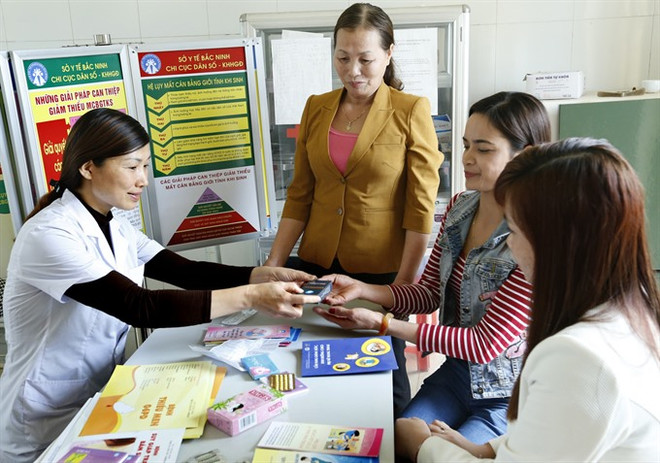 Health staff members introduce contraceptive methods to residents of Tu Son township in Bac Ninh province (Photo: VNA)
Health staff members introduce contraceptive methods to residents of Tu Son township in Bac Ninh province (Photo: VNA)Hanoi (VNA) -Troubled by low fertility rates in southern provinces, the Ministry of Healthhas proposed relaxing the country’s two-child policy in order to allowVietnamese parents to decide the number of children they want.
This was one of threepopulation planning proposals presented by the ministry at the 12th PartyCentral Committee’s sixth meeting underway in Hanoi.
The three suggestions,contained in a draft population law, include a differential policy of birthrate flexibly according to regions so that in areas with high fertility rate ofthree children per woman, families would be encouraged to have fewer than twochildren whereas in areas where the fertility rate is low, parents would beencouraged to have two children.
The second option wouldkeep in place the two-child policy, which encouraged parents to have only oneor two children. The third option would allow parents to decide.
Nguyen Van Tan, deputychief of the ministry’s General Office for Population and Family Planning, saidthe country has managed to maintain the ideal replacement level fertility of2.1 children per woman over the past decade. Replacement levels refer to abalance between the number of births and deaths.
Figures from Ho Chi MinhCity’s Department of Population and Family Planning show that Vietnam’s largestcity recorded fertility rates of 1.45 children per woman of childbearing age. Alow birth rate was also observed in the Mekong Delta region – between 1.5-1.6children per woman.
If the two-child policy ismaintained, and the birth rate is lower than the replacement rate, the countrywould face a series of problems, including social benefits for the elderly andlabour shortages in the next ten years, he said.
If the birth rate dropsbelow a certain level, it would be difficult to increase it, a problem faced byother Asian nations. Tan cited the Republic of Korea as an example of a countrythat maintained a limited birth rate policy until it decided to loosen thepolicy when the rate dropped to less than 1.6 children per woman in 1996.
However, this ratecontinued to decline further, reaching 1.08 children per woman in 2005. Thegovernment made efforts to encourage childbirth, adopting incentive policiesthat resulted in an increase up to an average of 1.27 children per woman in2012.
Some of the participants atthe discussion raised concerns of a population boom if the third option isimplemented, expressing support for the differentiated regional option.
However, Tan said thatbased on the experience of other countries, increasing the birth rate in areaswith low fertility would be difficult.
The draft population lawwill be discussed further before the Party Central Committee’s plenary sessionends on October 11.-VNA




























